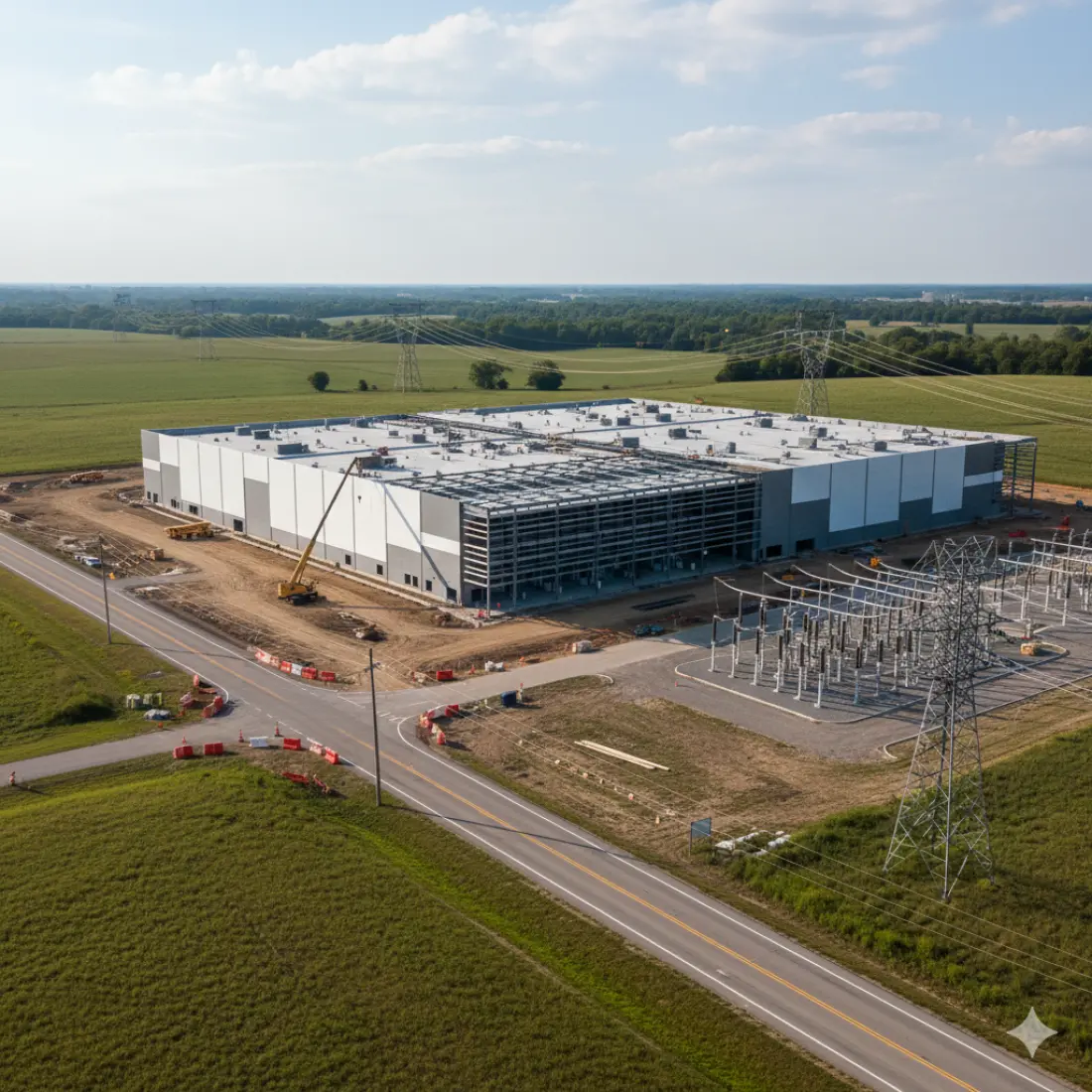AEP Ohio’s data center shift
Avoiding financial penalties for speculative power requests


As the gold rush for data center development continues to proliferate across the U.S., the high volume of speculative power requests and duplicative projects that developers are submitting to interconnection queues creates significant knock-on effects for grid planners and ratepayers alike.
One utility is taking a firm stance, and AEP Ohio’s recent policy shift has significant implications for data center developers: thorough, upfront due diligence on interconnection is key to avoiding substantial new financial penalties.
Understanding the AEP Ohio policy shift
Starting in July 2025, new requirements require developers to financially commit to the power they request, regardless of actual consumption.
This evolution in utility policy reflects a broader industry trend toward accountability for large loads in grid planning and operations.
How large load interconnection requests worked previously
The traditional process in AEP Ohio allowed developers to request large amounts of power capacity without strong commitments. Think of it like reserving multiple hotel rooms for a conference before knowing exactly how many attendees will show up.
Developers could submit interconnection applications requesting substantial nameplate capacity (the maximum power they might need). After the utility completed its interconnection study, developers had the flexibility to reduce their request or withdraw entirely with minimal financial consequences.
Some developers also submitted the same project at multiple locations to see which might be approved first, creating duplicate applications and adding additional complexity to the grid study process – only to have the project later be withdrawn.
Additionally, large loads – unlike smaller commercial offtakers – are responsible for paying for a portion of the network upgrade costs to improve the grid to supply power to the site. Often, developers do not understand the exact costs of network upgrades until they submit an application to the queue and the utility conducts an interconnection study. Once they see the bill for these upgrades, many developers back away.
This approach made sense from a development perspective—it gave teams room to explore possibilities. However, it created challenges for grid operators trying to plan long-term infrastructure investments and accurately model interconnection studies.
Why utilities are updating their approach
AEP Ohio faced a significant volume of interconnection requests—30 GW at peak—representing potential power demand. Consequently, the infrastructure investments required to get these online were substantial.
The transformers, transmission lines, and other equipment that grid operators decide to update are based on anticipated demand. When that demand doesn't materialize and help cover the network upgrade costs, it’s ratepayers who ultimately absorb them.
The impact included:
Inflated pipeline numbers and grid modeling complexity: Speculative requests created an unclear picture of actual grid needs and made it hard to forecast necessary grid upgrades
Inefficient resource allocation: Utilities struggled to prioritize genuine infrastructure needs
Cost implications: Ratepayers faced potential rate increases for infrastructure that wouldn't be fully utilized
This pattern emerged across multiple regions, prompting utilities to reconsider their interconnection policies. AEP Ohio's response represents a practical step toward more accurate grid planning.
The new requirements for data center developers
The 85% minimum payment rule
Under the settlement agreement proposed in October 2024 and that took effect in 2025, AEP Ohio requires new data center customers to pay for a minimum of 85% of their requested energy each month, regardless of actual usage.
This policy ensures that developers carefully consider their power requests before filing and have an understanding of the network upgrade costs they’ll be responsible for paying to achieve that power. This creates a direct financial connection between requested capacity and actual commitments.
However, it shouldn’t be regarded as a penalty in the traditional sense, but rather a cost-sharing mechanism. Developers now share responsibility for the infrastructure investments triggered by their interconnection requests.
What this means for project planning
Many developers traditionally approached interconnection applications with speculative capacity requests and a limited understanding of available power and upgrade costs, refining requirements later in the process after submitting them to the queue. This strategy now carries significant financial risk.
Building on proven project development practices, teams need enhanced due diligence before submitting applications. The stakes involve monthly payments that could impact project economics for years and financial penalties for withdrawing from the queue entirely.
Key planning considerations include:
Accurate facility power assessment: Understanding actual power consumption needed, not just theoretical maximums
Available power & network upgrade cost visibility: Conducting detailed studies in advance to understand where there’s power and how much network upgrade costs will run to achieve that amount of power before filing applications
Site suitability analysis: Conducting thorough power markets analysis and site due diligence in advance of interconnection request
The developers who thrive under these new requirements are those who invest in comprehensive analysis upfront.
This front-loads some work and due diligence costs but prevents bigger downstream financial penalties.
Facing the challenge: informed power analysis
The traditional consultant approach
Historically, data center developers relied on one-off consultant studies or even waited for a full utility study to analyze power availability at specific sites. A viable approach for certain locations, which becomes a challenge when screening multiple potential sites or trying to identify locations based on interconnection potential.
Limitations of the traditional approach:
Time constraints: Studies can take weeks or months to complete
Cost accumulation: Each site evaluation requires a separate investment
Limited comparison: Difficult to evaluate multiple locations simultaneously
No guarantee: Significant investment before knowing if the site will work
For developers managing tight timelines and budgets, these constraints create bottlenecks in the site selection process. The new AEP Ohio requirements only amplify these challenges by increasing the cost of mistakes.
Modern power analysis solutions
This is where PVcase Prospect provides immediate value for data center developers. Our Capacity solution provides instant insights into power availability and network upgrade costs nationwide for every point of interconnection.
The platform mimics the exact study process that each individual grid operator uses. This means developers can see accurate offtake capacity (power) in the context of the associated allocated upgrade costs — the infrastructure investments they'll be responsible for to achieve the desired power capacity at any interconnection point — before filing their interconnection applications.
How PVcase Prospect supports informed decision-making:
Know where to go: Dynamically evaluate power and upgrade costs with high-quality, mapped interconnection studies.
Immediate visibility: Instantly analyze power availability at multiple sites in minutes, not weeks
Cost transparency: Understand network upgrade costs for different project sizes (MW power) before committing to interconnection applications
Optimize project size: Quickly evaluate tradeoffs in upgrade costs versus additional power to target the optimal project size within your budget and timeline.
Risk mitigation: Avoid the 85% payment trap by accurately sizing projects from the start
This approach flips the traditional process on its head, improving your due diligence process with high-quality analysis upfront to target sites smartly and save on longer-term costs when entering the queue.
Building a stronger development process
Integrating power and interconnection analysis into workflows
Many successful developers have incorporated grid capacity analysis into their site selection process early on. Instead of choosing a location and then discovering power constraints, they're evaluating interconnection potential as a primary site selection criterion.
This "power-first" approach recognizes that grid connectivity often determines project viability. For data centers, access to reliable, affordable power isn't just important—it's foundational.
The enhanced workflow includes:
Early screening: Evaluate interconnection offtake capacity (power) during initial site identification
Cost modeling: Include realistic network upgrade costs in financial projections
Application accuracy: Submit interconnection requests sized to actual project needs
Risk management: Avoid financial penalties through informed capacity requests
However, the evolution in project development doesn't require abandoning proven practices. It means building on existing expertise with enhanced analytical tools.
Long-term advantages beyond AEP Ohio
While these strategies address AEP Ohio's specific requirements, they create value across all markets. Accurate capacity analysis benefits any data center development project, regardless of utility territory.
Understanding power availability and upgrade costs early in the process helps teams identify the strongest opportunities, which in turn leads to better site selection, more accurate financial modeling, and smoother interconnection processes. PVcase Prospect provides the capacity analysis tools that make this improved due diligence practical and efficient.
In any case, AEP Ohio may not be the only utility to adopt such accountability measures. Others might follow suit, as grid operators nationwide strive to balance growing demand with their existing infrastructure capacity.
Developers who build robust analysis capabilities now will be well-positioned for future policy evolution.


See how capacity analysis can strengthen your site selection process
Discover PVcase Prospect’s interconnection insights to navigate evolving utility requirements with confidence.


